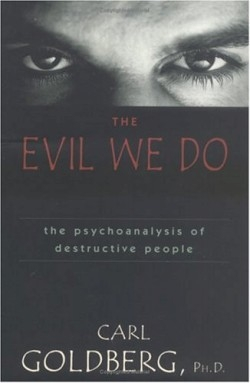The Evil We Do
The Psychoanalysis of Destructive People
Freud’s vision of psychoanalysis as a means of transforming society has failed. Destructive behavior and evil still flourish a century after his theories first attempted to explain, and subsequently modify, neurotic and psychotic behavior. Humanistic psychoanalyst Goldberg cogently argues that by broadening Freud’s vision to include moral imperatives, psychoanalysis will “become a torchlight of hope, compassion and responsibility for all of society.”
Contending that Freud’s inability to explain morality and human virtue has “profoundly straitjacketed psychoanalysis,” Goldberg hopes to revitalize the positive aspects of “the most influential contemporary theory of American society” by redefining its premises to include an emphasis on moral and social responsibility.
Through case studies that read more like stories than clinical analyses, Goldberg shows how destructive behavior can be linked, time and again, to a person’s inability to believe in his own goodness. By helping patients recognize that they have constructive options to destructive behavior, psychoanalysts can assist the patient in helping himself and, in turn, others. In that regard, Goldberg compellingly shows through his patients’ stories that “behind many disturbed lives resides a painful mystery.” By book’s end, it is clear that getting to the root of that mystery is not enough since “it does not by itself remove or excuse a person’s responsibility for [that] behavior.”
The centerpiece of the book might well be a chapter on the author’s own feeling of shame arising from the disparity between his well-being and a poverty-stricken child he once encountered in Peru. The experience helped him understand how shame can “play a crucial role as a guardian of virtuous behavior because of its role in the development of empathy and identification with others.” Thus, a feeling of shame can be used positively if it causes people to reflect on the difference between what they are and what they ought to be. It is Goldberg’s belief that those who cannot reflect on or articulate their shameful feelings choose to express themselves instead through destructive behavior.
The author provides methods developed through his practice on how psychoanalysts can shift the emphasis from the intrapsychic world to the “world of people.” Included is a section on using a special dialogue to promote understanding as well as methods for dealing with the feelings of shame and despair underlying a patient’s destructive behavior.
Overall, the book is a thoughtful treatise with profound implications for all individuals, especially those once believed to be unredeemable.
Reviewed by
Judy Hopkins
Disclosure: This article is not an endorsement, but a review. The publisher of this book provided free copies of the book to have their book reviewed by a professional reviewer. No fee was paid by the publisher for this review. Foreword Reviews only recommends books that we love. Foreword Magazine, Inc. is disclosing this in accordance with the Federal Trade Commission’s 16 CFR, Part 255.

